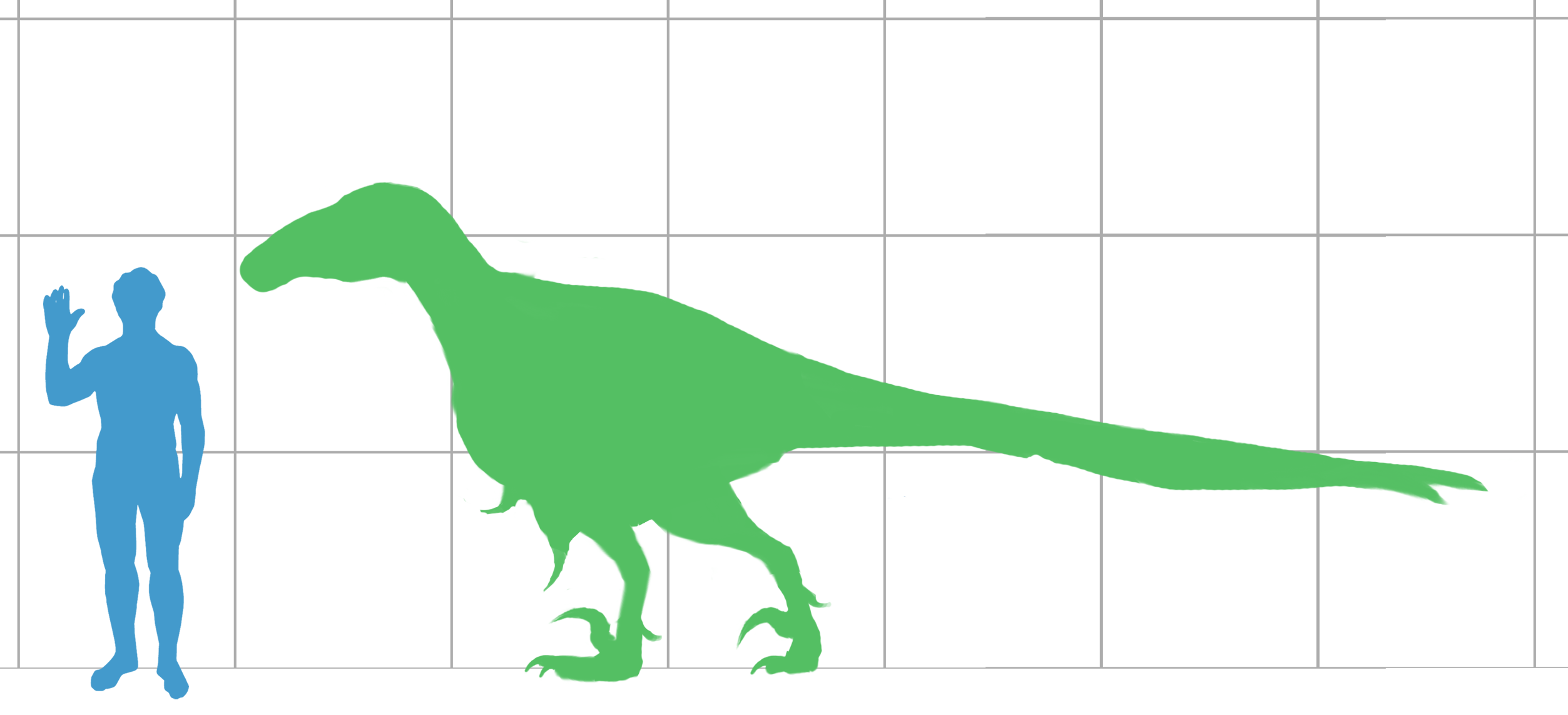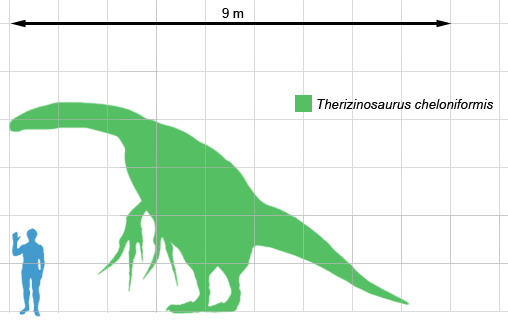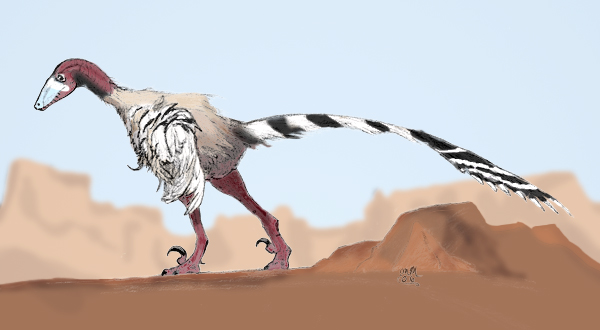How big is a big maniraptor? Some would say Deinonychus was a "big maniraptor", but truth be told it really... wasn't. Although it was fairly large for a dromaeosaurid, it still wasn't larger than even the largest living maniraptor, the ostrich. A large ostrich can easily weigh more than a hundred kilograms, while Deinonychus has been estimated at around seventy kilograms.
| Size comparison between several large aviremigian maniraptors (and a synapsid) by Matt Martyniuk, from Wikipedia. Notice Deinonychus sulking at the back out of embarrassment from being much smaller than the others. |
There are several dromaeosaurids that were much larger than Deinonychus, however. Achillobator, Austroraptor, and Utahraptor are the largest dromaeosaurids known. Utahraptor has been estimated at five hundred kilograms and seven meters long, and Achillobator and Austroraptor were probably slightly smaller. Some rumored undescribed specimens of Utahraptor are allegedly even larger, but for the sake of simplicity we can probably ignore those for now.
 |
| Size comparison between Utahraptor ostrommaysorum (including an alleged undescribed specimen) and a human by Matt Martyniuk, from Wikipedia. |
Large as they were, these large dromaeosaurids were dwarfed by several other maniraptors. The oviraptorosaur Gigantoraptor was more than eight meters long and weighed more than a ton. It was about the same size as the tyrannosaurids Albertosaurus and Gorgosaurus. Multiple therizinosaur taxa may have also rivaled or exceeded the biggest dromaeosaurids in mass, including Alxasaurus, Falcarius, Nothronychus, Suzhousaurus, Enigmosaurus, Erlikosaurus, Nanshiungosaurus, and Segnosaurus. The largest known therizinosaur (in fact, the largest known maniraptor) was Therizinosaurus itself. Some estimates put it as being around three meters tall at the hip and weighing as much as six tons. Given the strange, upright build therizinosaurs tended to have, it probably would've been a very imposing animal in life.
 |
| Size comparison between Therizinosaurus cheloniformis and a human by Matt Martyniuk, from Wikipedia. |
The concept that large maniraptors may have lost their feathers is based on the fact that several large modern tropical land mammal lineages (such as elephants, rhinos, and hippos) have greatly reduced insulating integument, which sounds reasonable. (It's a bit less reasonable when other types of mammals such as humans, naked mole rats, or whales are brought up, given that their reduction of hair involves specialized lifestyles not known in any maniraptor.) These mammals have dispensed with a thick coat of hair because they are large enough to maintain their body temperature without insulation, and probably because they'd overheat with a typical mammalian coat.
On the other hand, there's reason to think that overheating was not quite as much of a problem for theropods as it is for mammals. For one thing, theropods typically have greater surface to volume ratio than mammals do. After all, Velociraptor was roughly the size of a coyote, but was longer than the average man is tall. Even among mammals, surface area to volume ratio appears to make a difference in determining how much insulating integument is reduced. Giraffes and black rhinos are in the same size range, but giraffes haven't greatly reduced their coats of hair, because their surface area to volume ratio is much greater than that of black rhinos. It's worth noting that the builds of elephants, hippos, and rhinos are all terrible for shedding heat, while this was not the case with theropods. Secondly, theropods have an air sac system that mammals do not, and greatly increases their ability to shed excess heat. Indeed, preliminary calculations by Andrea Cau suggest that not even the tyrannosaurid Tyrannosaurus would've been greatly inconvenienced by a feather coat, and Tyrannosaurus was significantly larger than all known maniraptors, barring Therizinosaurus. I suspect the largest coelurosaur with a coat of plumage of a given thickness would've potentially been larger than the largest mammal with an equally thick hair coat.
Besides, there are other reasons why elephants, hippos, and rhinos don't make ideal comparisons to most big maniraptors. Rumors notwithstanding, Utahraptor, Achillobator, and Austroraptor weren't anywhere close to the size of those big mammals. Modern mammals in their size range, even those in tropical environments, don't show a particularly marked reduction in hair. (Funnily, the largest known avian maniraptors were about as large as the largest dromaeosaurids, but rarely does anyone suggest that they lost their feathers. Such baseless differences between the treatment of non-avian and avian maniraptors is quickly becoming an Overly Long Gag.) That leaves only Gigantoraptor, Nothronychus, Suzhousaurus, Segnosaurus, and Therizinosaurus as the only known maniraptors in the size range of large terrestrial mammals with reduced integument covering. Furthermore, the hair loss in hippos (and likely the ancestors of elephants) may well have as much to do with their semi-aquatic habits as it does with size and build, while there's no evidence that any big maniraptors had semi-aquatic ancestors.
 |
| Cartoon of hypothetical dromaeosaurids with lifestyles that may lead to significant reduction of insulating integument. Tellingly, none of them are known to have existed. |
There's more. Feathers, especially pennaceous feathers (which most maniraptors have) are excellent insulators. They prevent both heat loss from the body and overheating caused by ambient heat. We're biased in our typical view of insulation because we deal with high temperatures by sweating, which isn't too effective with thick clothing covering our skin, but in fact, male turkeys are more likely to overheat from high ambient temperatures than female turkeys are because of their bald heads. Even for us, wearing thin clothing that still allows for evaporation of sweat can actually help lower body temperature. That said, feather loss in some areas of the body in maniraptors can be beneficial under some circumstances. For example, ostriches have naked flanks, legs, and inner wings, and rheas have naked legs and inner wings. These birds can run very fast and probably generate a lot of heat doing so, but live in fairly arid environments and can remain active in hot weather. It turns out that the featherless parts of an ostrich or rhea can all be shaded easily by the bird's wings or the rest of the body, so the heat generated during the day is stored and then can be rapidly shed in one go. The bald heads of certain vultures have also been found to be important in thermoregulation (instead of being an adaptation to cope with messy feeding habits; indeed, the messiest vultures don't have the baldest heads, and most vultures have feathered heads). These vultures usually need to cope with rapidly changing temperatures while soaring, and can quickly facilitate or prevent heat loss by extending or retracting the neck. Even the bald heads of turkeys have a role in shedding metabolic heat.
So it's not improbable for some non-avian maniraptors to have had some naked parts of the body, either for display or thermoregulatory purposes, especially the neck. (Feathers in the neck region are genetically easier to lose than feathers elsewhere on the body, which explains why so many different bird lineages have evolved bald necks for various purposes.) In particular, large cursorial non-avian maniraptors that lived in arid environments may well have had an ostrich-like feather covering. Nevertheless, there is little reason to think that any maniraptor lost its feathers to the same degree elephants, hippos, and rhinos have lost their hair. Even in flightless birds with naked skin patches, the rest of the body still tends to be densely feathered. Indeed, wing feathers in aviremigian maniraptors don't have much to do with insulation and may well have been present in even the largest aviremigians. (They wouldn't have gotten in the way of predation. Might talk about that in a later post.) In fact, ostriches and rheas have even more remiges than flying birds because they no longer need to fly. They have remiges on both sides of the arm, while flying birds only have them on the same side as the ulna. Whether or not any extinct maniraptors had similar feather arrangement is unknown.
 |
| Restoration of Achillobator giganticus with plausible ostrich-like feather distribution by Matt Martyniuk. Derived dromaeosaurids weren't cursorial, but fulfilling two out of three requirements is close enough! |





Put this up on a public forum such as DeviantArt and watch the complaints of fan-boys roll in.
ReplyDeleteIn my experience, this is they're number 1 argument (other than simply "I don't like it so I won't believe it") for non-feathered maniraptors and they will refuse to hear any argument to the contrary.
I am also sick of Velociraptor being thrown in with this crowd to be honest. It is tiny. Like, seriously I don't get how people just can't see how small that species really is.
I haven't seen Velociraptor being considered a big maniraptor yet, but that would be pretty bad. Deinonychus is already a stretch, if that.
ReplyDeleteI have, lots of times. One of the first things people go to is often its size, and I'm always like: "but it's tiny..."
ReplyDeleteNot to mention it has direct evidence of feathers, too...
ReplyDeleteI actually had someone suggest that the quill knobs must have been faked because they would have been too hard to preserve.
ReplyDeleteI'm sure I don't have to say that I didn't bother arguing with that person any more.
Facepalm. Aside from the fact that more than one Velociraptor specimen is known to have preserved quill knobs, I'd think that quill knobs would be easier to preserve than actual feathers.
ReplyDeleteDon't we have scaly skin impressions from Tyrannosaurus, whose ancestors certainly had feathers?
ReplyDeleteKnown skin impressions from tyrannosaurids are as far as I know, very scrappy, and often can't be identified as belonging to specific parts of the body. Some are confirmed as being skin impressions from the underside of the tail or the throat, where we might expect scales to begin with, as we know that comparatively basal coelurosaurs had a more extensive covering of scales than maniraptors. (Juravenator preserves both scales and feathers, and possible scales have also been reported on the tail of Compsognathus.) The feathers preserved on Dilong are also very restricted and are known only from the top of the tail and the lower jaw. (There also appears to be a possible "large" tyrannosauroid from the Yixian that preserves feathers at least on the top of its tail. Watch that space.) It's quite possible that tyrannosaurids had feathers on other parts of the body. In fact, naked skin impressions has been reported for Gorgosaurus, which might suggest some secondary feather loss on some part of the body. There's also the occasional phylogenetic analysis where Dilong comes out as a more derived coelurosaur instead of a tyrannosauroid, so there's also a possibility that tyrannosaurids evolved before the origin of feathers. I suppose the take home message is that at this point we don't know as much about tyrannosauroid integument as we do about maniraptor integument.
ReplyDeleteI want to thank you for posting this series. Saves me a ton of hair-tearing-out whenever anyone breaks out the "but big mammals don't have hair" argument.
ReplyDeleteGlad it helps!
Delete